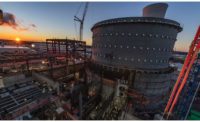“We proposed the new bridge with light rail and the connection to the commuter rail platform,” McFall says. “We proposed $57 million for the bridge, and in our partnership with UTA and Salt Lake City, we share in any cost overruns as well as share any savings.”
Schedule changes and a high water table pushed the design team to adjust materials used for bridge abutments. Howard says lightweight fill, geofoam and cellular concrete will be used to reduce settling time, speed up the schedule and cut costs.
In other locations along the rail line, the Stacy and Witbeck team has used fill removed from a second light-rail extension project underway in nearby West Valley City.
Matthew Hemsath, field engineer for Kiewit, says 45,000 cu yd of fill material from the project in West Valley was used as base for a section of the light-rail alignment that will be ballasted.
“About 90% of the fill we’ve used has come from the West Valley project, and that has lowered the environmental impact of this portion,” he adds. “We also had to disturb some wetlands out here (near the airport), but we’ve developed a new 40-acre wetland on the other side of the freeway to offset that.”
Work on a section near the Utah State Fair Park was completed to accommodate the State Fair in September.
The replacement bridge over the Jordan River, which flows from south to north through the Salt Lake Valley, was completed during the summer. The bridge design incorporated elements from the original bridge designed in the early 1910s.
Project Team
Owner: Utah Transit Authority, Salt Lake City Corp. and Salt Lake International Airport
General Contractors: Stacy and Witbeck Inc., Kiewit Western Co.
Project Designers: Wilbur Smith/ Steve Green and Associates
Drainage Design: David Evans & Associates
Architect: FFKR






Post a comment to this article
Report Abusive Comment